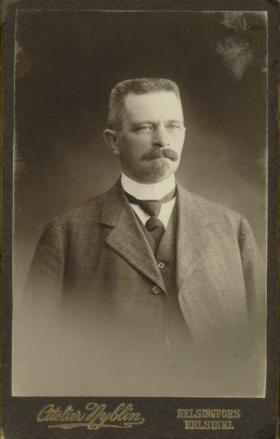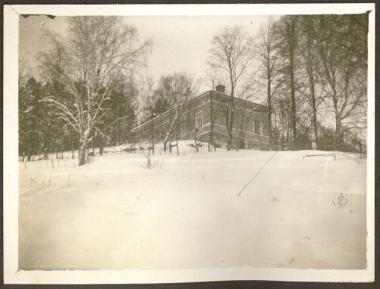Healthcare in Fiskars
In the summer of 1831, the Fiskars Ironworks was faced with cholera. The owner, apothecary Johan Jacob Julin prepared for the disease by stocking items for ten sick beds. He even applied for a licence for a doctor from the director of the board of medicine. The licence was denied, so Julin decided to isolate the whole Ironworks. It survived without any cases of cholera.
Ironworks Doctors
The first ironworks doctor was hired as early as 1860, much earlier than most other large communities got their own doctors. Even before this, occasional healthcare was provided at the ironworks. At the end of the 19th century, a doctor’s salary composed of payments made by all the workers. The amount of money paid by each worker depended on their marital status: the married paid 1 mark, 50 pennies, and the unmarried 1 mark. After making the payment, they were all entitled for free healthcare. Other habitants of the ironworks received healthcare for a small fee. People living on poverty grants received free healthcare.
Lennart Holm worked as a doctor in Fiskars between 1904-1920


In addition to a salary, a doctor’s perks included a flat and firewood. From the beginning, Rosehill, situated on a hill behind Slaggbyggnaden, was used as a doctor’s quarters. At first, the practice was in Rosehill, and before a pharmacy was set up, the doctor also maintained a small medicine storage.
Rosehill: The doctor’s quarters in Fiskars
From 1902, the ironworks doctor also worked as the doctor of the municipality of Pohja. In 1973, Fiskars Oy Ab took over occupational health services.
Doctors at Fiskars Ironworks
Albert Palmberg 1860-1867
Johannes Collan 1868-1869
K.K. Kyndberg 1869-1875
For a few years after 1875, the Ironworks didn’t have a doctor
E. Nilsson ???? – 1882
I. Rothström 1882-1892
O. Sahlberg 1892-1901
E. Juselius 1901-1904
L. Holm 1904-1920
T. Dreijer 1920-1943
L. Laqvist 1943-1973
Fiskars hospital
The Fiskars Hospital was opened in 1892. In the beginning, the hospital had ten beds and one nurse. In the 1920’s, the beds were increased to thirteen, and a second nurse was hired. After renovations at the beginning of the 1920’s, the hospital was capable of having twenty patients, and there were four nurses. There was also a child health clinic and an operation theatre. As early as 1947, the Ironworks got its own ambulance. Quick ambulance service was needed, as occupational accidents occurred every now and then at the factories.
The hospital was closed in 1958. Nowadays the building serves as flats.

Pharmacy
In 1887, chemist Wickroos opened a pharmacy in Pohja, but quickly moved to Fiskars the next year. The pharmacy operated in Kellotorni until 1975, and then moved back to the centre of Pohja.
Sources and literature
Holmström, Laura. Minnen från Fiskars. 1994.
Klevdal, Nils. Fiskars i dag och för 300 år sedan. 1949.
Nikander, Gabriel. Fiskars bruks historia. 1929.